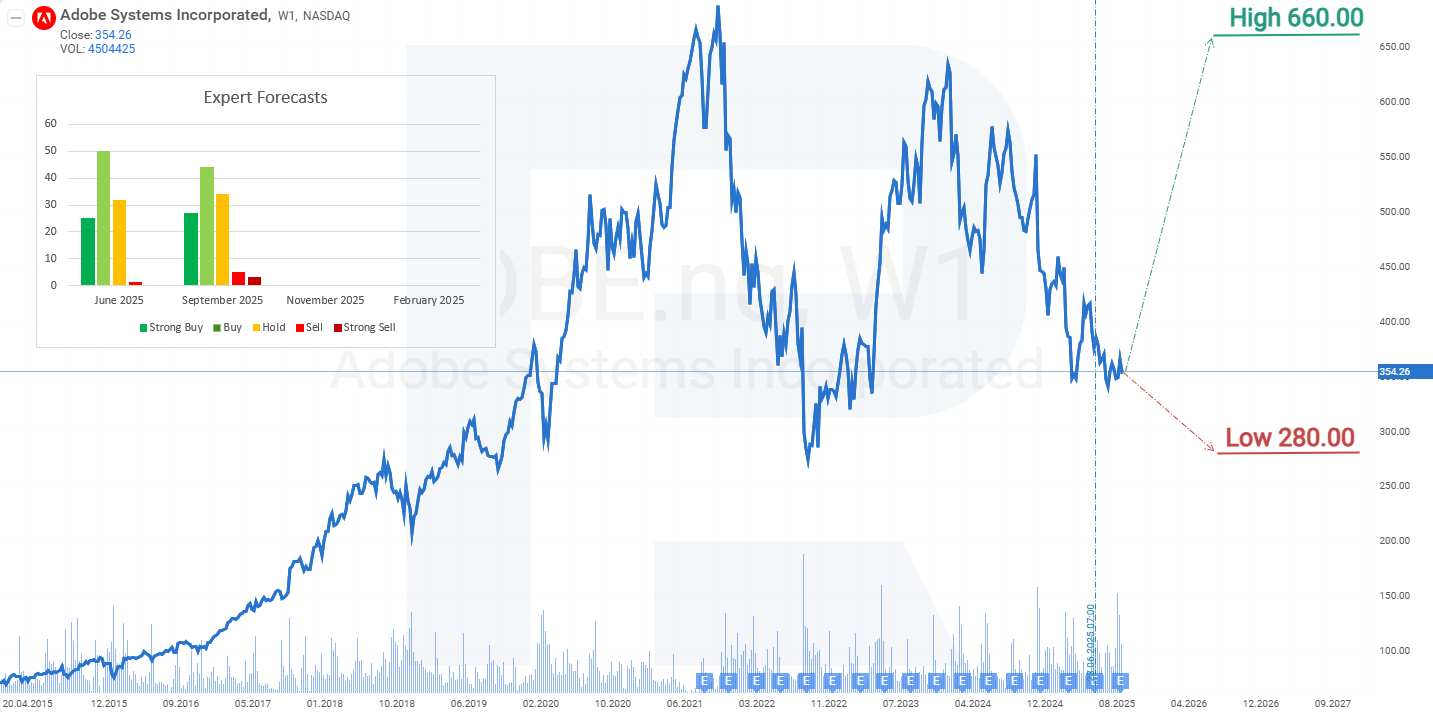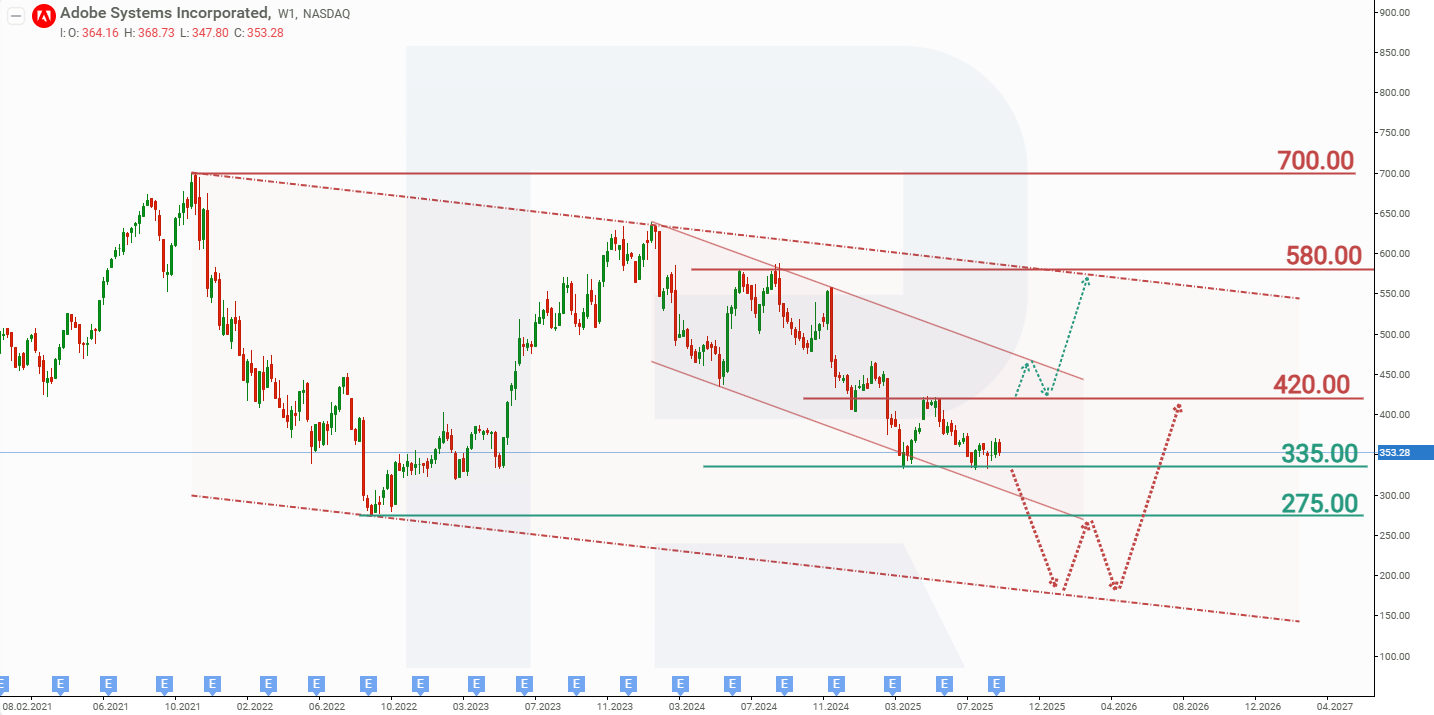Digital Media loses momentum – AI monetisation in question: what are the prospects for Adobe shares?
Adobe continues to demonstrate resilience, but investors are looking for faster growth in annual recurring revenue from Digital Media and a more tangible contribution from AI on financial results.
For Q3 FY2025, Adobe Inc. (NASDAQ: ADBE) beat analyst expectations, with revenue of 5.99 billion USD (+11% year-on-year) and non-GAAP earnings per share of 5.31 USD. Growth was mainly driven by subscriptions: Digital Media revenue rose 12%, with annual subscription volume reaching 18.59 billion USD. The company also reported progress in AI monetisation – annual recurring revenue (ARR) linked to AI products exceeded 5 billion USD, while revenue from new AI services surpassed its full-year target of 250 million USD ahead of schedule. Management raised its full-year outlook, guiding to revenue of 23.65–23.70 billion USD and EPS of 20.80–20.85 USD.
The market’s reaction to Adobe’s results was initially positive but quickly became more muted. Shares rose 3% in pre-market trading following the release but slipped back slightly by the close. Investors acknowledged the strong figures and encouraging AI news, yet saw little to justify a sustained rally. The next day’s subdued price action reinforced the impression of a solid but unspectacular report. Concerns focused on slowing ARR growth in Digital Media and uncertainty over how much generative AI would broaden Adobe’s addressable market – and how quickly this would translate into revenue. Additional pressure came from rating downgrades by Morgan Stanley and other analysts.
This article examines Adobe Inc., outlines its revenue sources, reviews Adobe’s performance in Q2 and Q3 FY2025, and sets out expectations for FY2025. It also provides a technical analysis of ADBE shares, forming the basis for an Adobe stock forecast for calendar 2025.
About Adobe Inc.
Adobe was founded in December 1982 by John Warnock and Charles Geschke. The company specialises in software for businesses and individual users through the Adobe Acrobat, Illustrator, Photoshop, and Premiere Pro applications. It also provides digital marketing and document management solutions through the Creative Cloud and Experience Cloud platforms. The company went public on 20 August 1986, listing its shares on the NASDAQ under the ticker symbol ABDE.
Image of the company name Adobe Inc.Adobe Inc.’s main revenue streams
Adobe’s revenue comes from the following sources:
- Digital Media : products and solutions that help create, edit, and distribute digital content. This segment enables users to work with graphics, video, animation, web design, and other digital media. It forms the core of Adobe’s business
- Digital Experience : business solutions that improve client interaction through digital channels. This includes Adobe Experience Cloud, which offers analytics, marketing campaign management, content personalisation, and client experience optimisation tools. It helps businesses analyse data, automate marketing processes, and create a seamless user experience across websites, apps, and other platforms
Since Q1 of fiscal year 2025, Adobe has begun providing information on subscription revenue by creating two groups:
- Business Professionals and Consumers Group : this group includes revenues from Acrobat, Adobe Express, and Document Cloud subscriptions.
- Creative and Marketing Professionals Group : includes revenues from Digital Experience subscriptions and all other Creative Cloud subscriptions.
Adobe Inc. Q1 FY2025 report
On 12 March, Adobe Inc. released its Q1 fiscal 2025 report for the period ending on 28 February 2025. Below are its highlights:
- Revenue : 5.71 billion USD (+10%)
- Net income : 2.22 billion USD (+8%)
- Earnings per share : 5.08 USD (+13%)
- Operating income : 2.71 billion USD (+10%)
Revenue by segment:
- Digital Media : 4.23 billion USD (+11%)
- Digital Experience : 1.41 billion USD (+10%)
- Business Professionals and Consumers Group : 1.53 billion USD (+15%)
- Creative and Marketing Professionals Group : 3.92 billion USD (+10%)
Commenting on its record Q1 FY 2025 revenue, Adobe’s management emphasised the significant role of AI-based innovation. CEO Shantanu Narayen stated that Adobe’s AI achievements drive creative economic growth. In particular, he noted that AI-focused products (Acrobat AI Assistant, Firefly App, and GenStudio) generated over 125.00 million USD in revenue, which is expected to double by the end of the fiscal year 2025.
As part of its Q2 fiscal 2025 financial targets, Adobe expects total revenue to be between 5.77 and 5.82 billion USD and EPS between 4.95 and 5.00 USD. The company also anticipates an operating margin of approximately 45%. In the Digital Media segment, Adobe expects revenue of 4.27-4.30 billion USD. Overall, these forecasts align with analysts’ expectations. However, following their release, the company’s stock fell by over 14% as investors voiced concerns about the pace of monetising Adobe’s AI initiatives.
Adobe Inc. Q2 FY2025 report
On 12 June, Adobe Inc. released its Q2 fiscal 2025 results for the period ending 30 May. Below are its key highlights:
- Revenue : 5.87 billion USD (+10%)
- Net income : 2.17 billion USD (+8%)
- Earnings per share (EPS) : 5.06 USD (+13%)
- Operating profit : 2.67 billion USD (+10%)
Revenue by segment:
- Digital Media : 4.35 billion USD (+11%)
- Digital Experience : 1.46 billion USD (+10%)
- Business Professionals and Consumers Group : 1.60 billion USD (+15%)
- Creative and Marketing Professionals Group : 4.02 billion USD (+10%)
Adobe reported a strong performance in Q2 fiscal 2025, with revenue reaching 5.87 billion USD, up 11% year-on-year. Growth was underpinned by sustained demand for Creative Cloud products and robust performance in the Digital Experience segment.
Artificial intelligence remains a key growth driver, with Firefly (image and video generation), Acrobat AI Assistant, Adobe Express and GenStudio contributing to increased user engagement. Adobe stated that it expects to exceed 250 million USD in annual revenue from AI products by year-end.
Management raised its full-year 2025 guidance. Revenue was expected in the range of 23.50-23.60 billion USD and EPS at 20.50-20.70 USD, both above previous estimates. For Q3 FY2025, Adobe projected non-GAAP EPS of 5.15-5.20 USD and revenue of 5.87-5.92 billion USD, also above analysts’ consensus forecasts. The operating margin was anticipated at around 45.5%.
The company’s cash flows remained strong, with an operating cash flow of 2.19 billion USD and 3.5 billion USD spent on share buybacks. A further 10.9 billion USD remained in repurchase reserves, supporting shareholder value.
Nevertheless, the shares came under pressure as investors grew concerned about intensifying competition in AI-based solutions from players such as Canva, OpenAI, and Alphabet Inc. The market was also waiting for firm evidence that AI integration would deliver sustained margin expansion rather than remain just a buzzword.
Adobe Inc. Q3 FY2025 report
On 11 September, Adobe Inc. published its results for Q3 FY2025, which ended on 29 August. The key figures are as follows:
- Revenue : 5.99 billion USD (+11% year-on-year)
- Net profit : 2.25 billion USD (+8% year-on-year)
- Earnings per share (EPS) : 5.31 USD (+14% year-on-year)
- Operating profit : 2.77 billion USD (+10% year-on-year)
Revenue by segment:
- Digital Media : 4.46 billion USD (+12% year-on-year)
- Digital Experience : 1.48 billion USD (+9% year-on-year)
- Business Professionals and Consumers Group : 1.65 billion USD (+15% year-on-year)
- Creative and Marketing Professionals Group : 4.12 billion USD (+11% year-on-year)
Adobe outperformed expectations in Q3 FY2025. Revenue was 5.99 billion USD (+11% year-on-year), while non-GAAP EPS reached 5.31 USD – both ahead of analyst estimates of 5.92 billion USD in revenue and 5.18 USD in EPS. Growth was driven primarily by subscription products, with Digital Media revenue rising to 4.46 billion USD (+12% year-on-year) and annual recurring revenue (ARR) in this segment reaching 18.59 billion USD (+11.7% year-on-year). Digital Experience contributed 1.48 billion USD (+9% year-on-year), while remaining performance obligations (RPO) rose to 20.44 billion USD, of which 67% are short-term. Operating cash flow totalled 2.20 billion USD, and the company repurchased around 8 million shares.
A key positive was management’s upward revision of full-year guidance: Adobe now anticipates revenue of 23.65–23.70 billion USD and non-GAAP EPS of 20.80–20.85 USD. Progress in AI monetisation was also highlighted: ARR linked to AI features surpassed 5 billion USD, while revenue from new AI products already exceeded the full-year target of 250 million USD in the latest quarter.
However, the report also included factors that concerned investors. Growth in Digital Media ARR slowed compared with previous periods, and the outlook for monetising generative AI remains uncertain against a backdrop of intensifying competition. These issues tempered market optimism despite the strong results.
For Q4 FY2025, Adobe projects revenue of 6.075–6.125 billion USD, GAAP EPS of 4.27–4.32 USD and non-GAAP EPS of 5.35–5.40 USD. Expected segment revenue includes 4.53–4.56 billion USD from Digital Media and 1.495–1.515 billion USD from Digital Experience.
Expert forecasts for Adobe Inc.’s stock
- Barchart : 23 of 36 analysts rated Adobe shares as Strong Buy, 2 as Moderate Buy, 9 as Hold, and 2 as Strong Sell. The top-end forecast is 660 USD, with the lower-end forecast at 280 USD
- MarketBeat : 15 of 27 analysts assigned a Buy rating, 9 recommended Hold, and 3 advised Sell. The top-end forecast is 590 USD, with the lower-end forecast at 280 USD
- TipRanks : 17 of 27 analysts rated the stock as Buy, 8 as Hold, and 2 as Sell. The top-end forecast is 590 USD, with the lower-end forecast at 280 USD
- Stock Analysis : 4 of 23 experts rated Adobe shares as Strong Buy, 10 as Buy, 8 as Hold, and 1 as Strong Sell. The top-end forecast is 590 USD, with the lower-end forecast at 280 USD
Adobe Inc. stock price forecast for 2025
On the weekly chart, Adobe shares are trading within a downward channel. If the company fails to prove the effectiveness of its AI investments and does not accelerate ARR growth in Digital Media, pressure on the stock could intensify. Based on the current performance of Adobe shares, the two possible outcomes for 2025 are as follows:
- Base case forecast for Adobe shares : this assumes a break below support at 336 USD, with the share price subsequently falling to the lower boundary of the channel at around 200 USD. This scenario reflects growing investor concerns over slowing ARR growth in the Digital Media segment, as well as limited returns from investments in generative AI.
- Alternative outlook for Adobe stock : this assumes a breakout above resistance at 420 USD, followed by a rally towards 580 USD. This scenario may materialise after a positive reassessment by analysts if the company begins to clearly demonstrate how generative AI is expanding its client base and broadening its addressable market.
Risks of investing in Adobe Inc. stock
Investing in Adobe stock involves several risks that may negatively impact the company’s profitability, revenue, and investor returns:
- Macroeconomic factors : Adobe’s performance is influenced by the broader global economy. Economic downturns and geopolitical events may adversely affect the company’s financial position
- Competitive environment : the emergence of new competitors, including affordable AI models from startups such as DeepSeek, threatens Adobe’s market share. Intensified competition may exert pricing pressure and reduce profitability
- Market volatility : Adobe’s financial performance is subject to market fluctuations and other macroeconomic factors. Investors should consider portfolio diversification to mitigate the risks associated with investing in the company’s shares
Forecasts presented in this section only reflect the author’s private opinion and should not be considered as guidance for trading. RoboForex bears no responsibility for trading results based on trading recommendations described in these analytical reviews.




